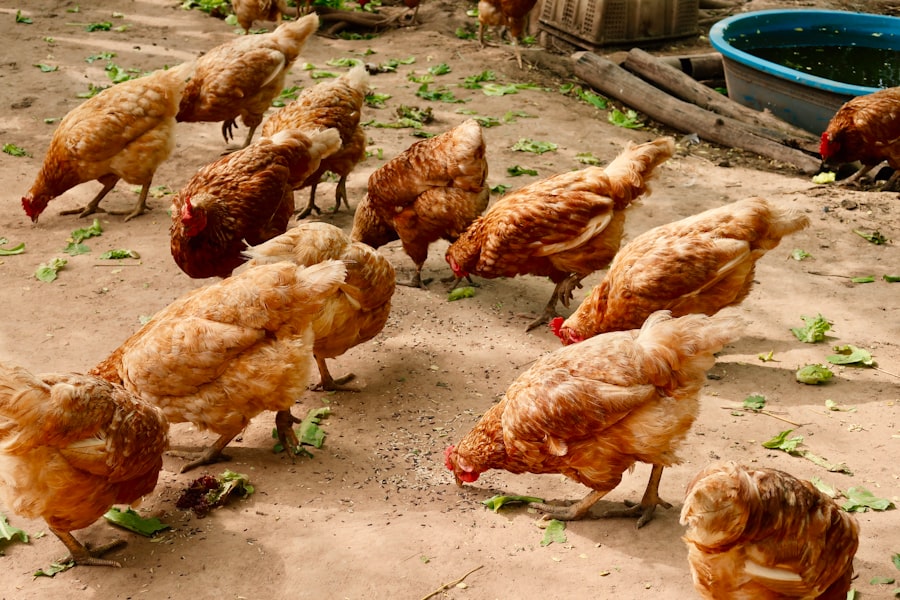Keeping chickens warm in winter is a crucial aspect of responsible chicken ownership. As the temperature drops and the days become shorter, it is important to ensure that your feathered friends are well taken care of during the colder months. Cold weather can pose various risks to chickens, including frostbite, hypothermia, and decreased egg production. By taking the necessary steps to keep your chickens warm, you can ensure their health and well-being throughout the winter season.
Key Takeaways
- Keeping chickens warm in winter is crucial for their health and well-being.
- Preparing your chicken coop for winter involves insulating it and providing adequate ventilation.
- Choosing the right bedding material and providing a heat source can also help keep chickens warm.
- Keeping water from freezing and feeding chickens properly are important tasks in winter.
- Monitoring your chickens’ health and well-being in winter is essential to ensure they stay healthy.
Understanding the Importance of Keeping Chickens Warm in Winter
Keeping chickens warm in winter is essential for their survival and overall health. Chickens are naturally equipped to handle cold temperatures to some extent, but extreme cold can be detrimental to their well-being. When chickens are exposed to freezing temperatures for prolonged periods, they are at risk of developing frostbite on their combs, wattles, and feet. Frostbite can cause tissue damage and lead to infection if left untreated.
In addition to frostbite, chickens can also suffer from hypothermia if they are not kept warm enough. Just like humans, chickens need to maintain a certain body temperature to function properly. When their body temperature drops too low, it can lead to lethargy, decreased appetite, and even death.
Furthermore, cold weather can also affect egg production in chickens. As the temperature drops, hens may reduce or stop laying eggs altogether. This is because their bodies prioritize staying warm over producing eggs. By keeping your chickens warm in winter, you can help maintain their egg production and ensure a steady supply of fresh eggs.
Preparing Your Chicken Coop for Winter
Preparing your chicken coop for winter is an important step in keeping your chickens warm and comfortable during the colder months. Start by thoroughly cleaning the coop and removing any debris or waste that may have accumulated. This will help prevent the buildup of moisture and bacteria that can lead to respiratory issues in chickens.
Next, check for any drafts or gaps in the coop that could let cold air in. Seal any cracks or holes with caulk or weatherstripping to keep the coop insulated. It is also a good idea to install windows or vents that can be opened and closed to provide proper ventilation without letting in too much cold air.
Additionally, consider adding extra bedding to the coop. Straw or wood shavings make excellent bedding materials as they provide insulation and help retain heat. Make sure to regularly clean and replace the bedding to maintain a clean and dry environment for your chickens.
Insulating Your Chicken Coop
Insulating your chicken coop is another important step in keeping your chickens warm during winter. Insulation helps trap heat inside the coop and prevents cold air from seeping in. There are several types of insulation you can use, including foam boards, fiberglass batts, or reflective insulation.
Foam boards are a popular choice for insulating chicken coops as they are easy to install and provide excellent insulation. Simply cut the foam boards to fit the walls of your coop and secure them in place with adhesive or screws. Fiberglass batts can also be used, but they require more careful handling as the fibers can irritate the skin and respiratory system.
Reflective insulation is another option that can help keep your chickens warm. This type of insulation reflects heat back into the coop, preventing it from escaping through the walls. Reflective insulation typically comes in rolls that can be cut to size and stapled or glued to the walls of the coop.
Providing Adequate Ventilation
While it is important to keep your chickens warm, it is equally important to provide adequate ventilation in the coop. Proper ventilation helps remove moisture, ammonia, and other gases that can build up inside the coop and cause respiratory issues in chickens.
To provide proper ventilation without making your chickens too cold, consider installing windows or vents that can be opened and closed as needed. This allows you to control the airflow and prevent drafts. It is also important to regularly clean the coop to remove any waste or debris that can contribute to poor air quality.
Choosing the Right Bedding Material

Choosing the right bedding material is crucial for keeping chickens warm in winter. The bedding material not only provides insulation but also helps absorb moisture and keep the coop dry. There are several options available, including straw, wood shavings, and shredded paper.
Straw is a popular choice for chicken bedding as it provides excellent insulation and helps retain heat. It is important to use straw that is clean and dry to prevent mold or mildew from forming. Wood shavings are another good option as they provide insulation and absorb moisture effectively. Avoid using cedar shavings as they can be toxic to chickens.
Shredded paper can also be used as bedding material, but it may not provide as much insulation as straw or wood shavings. However, it is a good option if you have limited access to other bedding materials. Make sure to use non-toxic ink and avoid glossy or colored paper.
Providing a Heat Source
Providing a heat source in the chicken coop can help keep your chickens warm during extremely cold weather. There are several types of heat sources you can use, including heat lamps, radiant heaters, or heated pads.
Heat lamps are a popular choice as they provide direct heat and can be easily adjusted to the desired temperature. However, it is important to use caution when using heat lamps as they can be a fire hazard if not properly installed or monitored. Make sure to secure the heat lamp in a safe location away from flammable materials and check it regularly for any signs of damage.
Radiant heaters are another option that provide gentle, radiant heat without the risk of fire. These heaters are typically mounted on the ceiling of the coop and emit infrared heat that warms the chickens directly. They are a safer alternative to heat lamps but may not provide as much heat in extremely cold temperatures.
Heated pads or mats can also be used to provide warmth to chickens. These pads are placed on the floor of the coop and provide a warm surface for the chickens to rest on. They are a safe and energy-efficient option but may not provide enough heat in very cold weather.
Keeping Water from Freezing
Keeping your chickens’ water from freezing is essential for their hydration and overall health. Chickens need access to fresh water at all times, even in winter. There are several methods you can use to prevent water from freezing, including heated waterers, insulated waterers, or using warm water.
Heated waterers are specifically designed to prevent water from freezing. These waterers have built-in heating elements that keep the water at a constant temperature above freezing. They are a convenient option but require access to electricity.
Insulated waterers are another option that can help prevent water from freezing. These waterers have double-walled construction with insulation in between to keep the water insulated and prevent freezing. They are a good option if you do not have access to electricity.
If you do not have access to heated or insulated waterers, you can use warm water to prevent freezing. Simply fill the waterers with warm water multiple times throughout the day to ensure that the chickens have access to liquid water. It is important to monitor the water regularly and replace it if it becomes too cold or frozen.
Feeding Your Chickens Properly
Feeding your chickens properly in winter is crucial for their health and well-being. During colder months, chickens require additional calories to maintain their body temperature and stay warm. It is important to provide them with a balanced diet that includes a mix of grains, protein, and fresh fruits and vegetables.
Grains such as corn, oats, and barley are excellent sources of energy and can help keep chickens warm. Protein-rich foods such as mealworms, sunflower seeds, or soybean meal are also important for maintaining muscle mass and overall health.
Fresh fruits and vegetables are a good source of vitamins and minerals that are essential for chickens’ immune system and overall health. Offer a variety of fruits and vegetables such as apples, carrots, kale, or spinach to ensure that your chickens receive a well-rounded diet.
Monitoring Your Chickens’ Health and Well-being in Winter
Monitoring your chickens’ health and well-being in winter is crucial to ensure that they are thriving in the colder months. Keep an eye out for any signs of illness or distress, such as lethargy, decreased appetite, or abnormal behavior. It is also important to regularly check their combs, wattles, and feet for any signs of frostbite.
Provide your chickens with plenty of fresh water and ensure that it does not freeze. Check their waterers multiple times throughout the day to make sure they have access to liquid water. Additionally, monitor their egg production to ensure that it remains consistent.
Regularly clean the coop and remove any waste or debris that can contribute to poor air quality. Replace the bedding as needed to maintain a clean and dry environment for your chickens. It is also important to provide them with enough space to move around and exercise, even during colder months.
Keeping chickens warm in winter is essential for their health and well-being. By taking the necessary steps to prepare your chicken coop, insulate it properly, provide adequate ventilation, choose the right bedding material, provide a heat source, keep water from freezing, feed your chickens properly, and monitor their health and well-being, you can ensure that your feathered friends stay warm and healthy throughout the colder months. Remember to always prioritize their safety and comfort by providing them with a clean and dry environment. With proper care and attention, your chickens will thrive even in the coldest of winters.
If you’re looking for ways to keep your chickens warm during the winter months, you’ll definitely want to check out this helpful article on poultrywizard.com. They provide valuable insights and tips on how to create a cozy and insulated farmhouse chicken coop that will keep your feathered friends comfortable and protected from the cold. With practical advice on everything from choosing the right materials to proper ventilation, this article is a must-read for any chicken owner. To learn more, click here: https://poultrywizard.com/keeping-chickens/farmhouse-chicken-coop/.
FAQs
What temperature range is safe for chickens in winter?
Chickens can tolerate temperatures as low as 20°F, but it is recommended to keep their coop between 32°F and 50°F.
How can I keep my chicken coop warm in winter?
You can keep your chicken coop warm in winter by insulating the walls and roof, using a heat lamp or ceramic heater, providing plenty of bedding, and sealing any drafts.
What kind of bedding should I use to keep my chickens warm in winter?
Straw, hay, or pine shavings are good choices for chicken bedding in winter. Avoid using materials that retain moisture, such as newspaper or sawdust.
Do I need to provide extra food and water for my chickens in winter?
Yes, chickens need extra food and water in winter to maintain their body temperature. Provide them with high-quality feed and fresh, unfrozen water.
Can I let my chickens roam outside in winter?
Yes, chickens can go outside in winter, but make sure they have a dry, sheltered area to retreat to if they get too cold. Also, be sure to check for ice and snow buildup on their feet and feathers.
Meet Walter, the feathered-friend fanatic of Florida! Nestled in the sunshine state, Walter struts through life with his feathered companions, clucking his way to happiness. With a coop that’s fancier than a five-star hotel, he’s the Don Juan of the chicken world. When he’s not teaching his hens to do the cha-cha, you’ll find him in a heated debate with his prized rooster, Sir Clucks-a-Lot. Walter’s poultry passion is no yolk; he’s the sunny-side-up guy you never knew you needed in your flock of friends!







